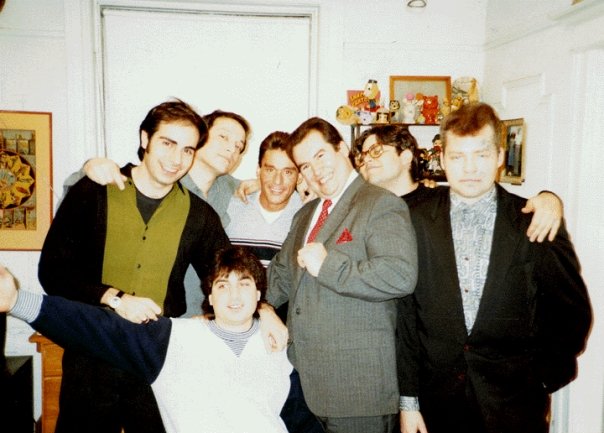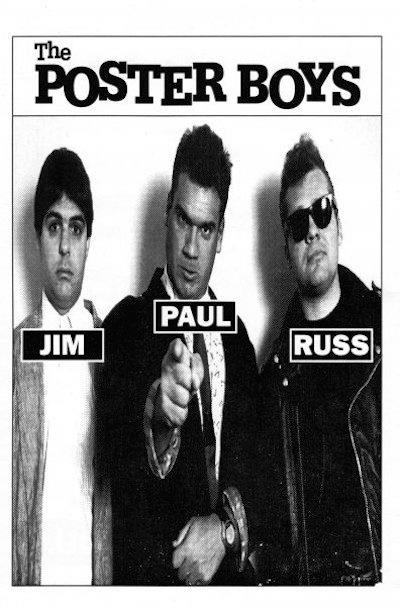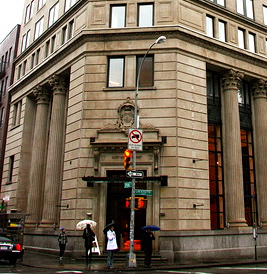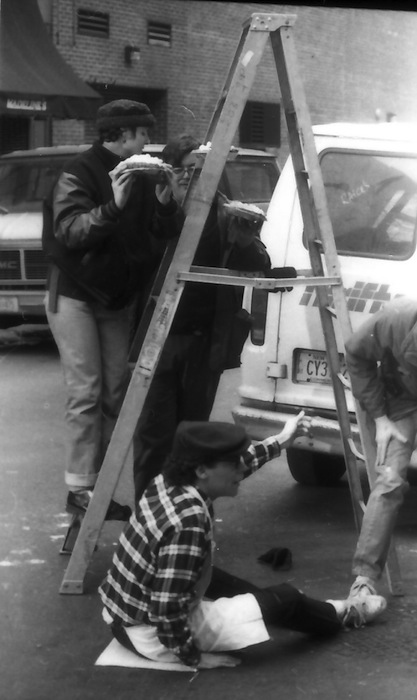by
Vincent Giordano

“The song is a ghetto tale, it’s dire and heart-wrenching. If you represented the story in a video, MTV wouldn’t go anywhere near it. So instead, Rick played it for laughs.”
• Bill Adler,
I Want My MTV“The late 1980s were Slick Rick’s moment. And the song on that first album, the one about the young kid who found himself sucked into a life of crime, remains his high-water mark. “Children’s Story” anticipates the crime-obsessed music to come later, but along with Rick’s characteristic narrative style, there is also a childlike quality echoed by the video made for it, which featured Keystone Kops, cluelessly chasing the young thief.”
– Julia Reischel,
Slick Trouble
Russell Simmons called out of the blue one day and asked us to submit a concept for the new Slick Rick song Children’s Story. Rick Rubin had departed for LA and Def American, so Russell was running the Def Jam ship now. We had worked with Slick Rick previously on the film Tougher Than Leather where he performed the song Treat Her Like A Prostitute. I liked him, he was easy to work with and he definitely had a unique vibe to him. The song to me was memorable in that when the MPAA rating board was reviewing Tougher Than Leather, the chief reviewer demanded the full lyrics to Treat Her Like A Prostitute and nothing else before coming to a final rating decision. We quickly scrambled up a lyric sheet, made some minor adjustments and shot it off to them. I thought in light of everything else in the film that this one song somehow stood out to them was comical.
The new song was unique and original. Problem was a concept. Menello was uncomfortable as a director going into the hardcore, street territory with a story mirroring the edgey, cautionary tale implied by the lyrics. The only other thing to do was to play it in the opposite direction, giving it a sense of humor and playfulness, closer to the opening of the song, a tone set up by Slick Rick himself:
“Uncle Ricky, could you read us a bedtime story?
Please, huh, please?
Alright, you kids get to bed, I’ll get the storybook
Y’all tucked in?Yeah, here we go
Once upon a time, not long ago…”
We ran through an endless cycles of ideas. The one thing with music videos is a time factor. Get the treatment in and the budget approved then it’s usually due yesterday. So we needed things we could grab around us that could be utilized quickly to get whatever idea Ric had up and running in a short amount of time. I had an old idea for a silent project I wanted to do with my college friend, actor John Mariano that never took hold. In college, there was a small group of us who specialized in making silent comedies that grew in sophistication and ambition as years went by. This group, many of which started in High School, were soley dedicated to that asesthetic as filmakers and performers. If I could get them together and use their skill, imagination and knowledge married with Ric’s ideas and direction we could have possbily have something that could work.


Ric immediately responded to the idea using the silent film comedy as a central focus of the video then framing with it modern color sequences. The problem remained that we needed the actual performers that could do the routines and actions. I reached out to John Mariano who had relocated to Los Angeles, to pursue his acting career. He was immediately in and since his family lived in Queens it made it all the more easier to come East quickly. We then recruited Bob Greenberg, the mastermind and director of many of the college silent comedies. The two of them would play the dual roles of the major Keystone cops as well as the fumbling bank robbers.


The rest of cast filled out with our other college friends and performers including Rob Costello and the late Russ Reiley. Russ was involved in an up and coming comedy troupe, the Poster Boys, that included Jim Giordano and Paul Parducci and with their inclusion we completed the roster of our Keystone cops.


Ric now had a clear direction with a cast that could deliver what he wrote. He recalls, “Russell Simmons asked me to direct “Children’s Story” for Slick Rick. And Russell wanted midgets…”
I had previously worked with Little Jimmy on Adam Yauch’s hilarious directorial debut music video for a song called Bodyguard. I suggested him even though on that video he threw a tantrum and walked off the set. I was actually in it as a pirate who swung in like Errol Flynn and tried to chop down Jimmy with a wooden sword. He claimed I struck him with the sword and was trying to kill him. I have trained with swords for 4 decades throughout Southeast Asia and if hit someone they are going to know about it. I never came close to even touching him and the sword was weightless and would crack if you struck someone to boot.


Nonetheless, Little Jimmy had grown a mustache and I thought he looked like the silent film comedian Snub Pollard, who did one of my favorite short silent comedies, It’s A Gift. Originally, I tried to sneak in the gag with Snub in his magneto car being pulled along by a magnet he aims at passing cars, as the final image of the video after the Keystone Cops chase Slick Rick’s limo but we couldn’t fit it in.
Ric was delighted how much he looked like Snub Pollard and wanted to use him but he additionally wanted another little person who proved more troublesome than even Jimmy. So we winded up with just Little Jimmy and that worked because the story is directed to him in the opening.
The same way the treatment was coming together so were the locations. Tony Martinez was an expert at hunting locations and suggested using the streets around our office on Lafayette Street to minimalize company moves. We wanted to use the Alice in Wonderland statue on another video but the video didn’t happen. Ric immediately felt that was the right location for the opening and closing. Budgetary considerations for shooting there at night included a generator, holding, transport, meals and Tony began working on that.
The idea was the color sections would frame the black and white vignettes. Slick Rick would sit high on the statue in one part doing his ryhmes then also be down over the bed placed at the base of the statue with Little Jimmy and two women.


Ric wanted the locations to have an old feel but still be in the modern world. The East River Savings Bank on the corner of where our production office was located at the time was perfect. It was built in the late 20s and had a great façade so we could pan down right into the spinning doorway as the two bank robbers escape.

The only problem was they kept telling us we couldn’t shoot there. We tried everything including sending letters but the answer was still no.
We had shot previously at the 23rd Police Precinct on 30th street, which was built in 1907 and it had the perfect exterior as well as the interior cells and a cops front desk we could access and shoot in easily.


The first day of the shoot we shot on the streets of Soho near our office. Most of it with the Keystone Cops doing their gags and chasing Slick Rick.

The only sticking point was the bank. I had my heart set on the East River Bank location. They refused every time we asked. It angered me to no end. The Chemical Bank we had as a back up didn’t work as well visually. Since things were going so well, Ric and I decided to steal the shot.
1st AC Michael Garfalo and I raced over and set everything up. We aimed the camera away from the bank, making it look like we were getting an establishing shot of the street. One problem was we had a damn Panaflex. We had a back up camera, for the night shoot because it was going to be freezing out for Central Park, but it was also a Panaflex. We needed something less conspicuous. We radioed back for Ric then John and Bob, now fully dressed as the bank robbers. We discussed before we left that we would get two takes at best before we would have to bolt out of there.
One thing we could count on was John and Bob delievering right out of the box. Take One was off by a bit so we kept the camera rolling and hit take two then raced off without looking back.
All hell broke loose when the bank called the Mayor’s office to complain about the incident. By then, we were ready to make our company move to finish up the next sequence. The Mayor’s office wanted to pull our permit, which could spell disaster for the next day’s night shoot in Central Park. We luckily smoothed over everything with them, never accepting the fact that it was indeed us shooting at the bank but remaining only on our designated, permitted locations.

The next night, it was freezing in Central Park so we had to contend with the cold weather. The crew was excellent and we got the bed in place, dolly track and lighting set up at the Alice Statue in a good amount of time.
Slick Rick was excellent throughout. He was always ready to go and enthusiastic to perform. We were able to get his material shot quickly on both days.
We were headed for a near flawless shoot when Little Jimmy began acting up.
Ric explains, “Little Jimmy walks out about three-quarters of the way through the video. He kept saying, “I want to dance.” So I had him dance on the bed. Suddenly he goes, “You’re making fun of me!” He jumped up, landed on the bed, belly flopped off, and walked away. Slick Rick’s DJ, Vance, followed him, yelling, “Yo, midget dick! Don’t ever show your face again.”

I couldn’t believe that Little Jimmy would again walk off for no good reason. I chased him down and told him to get back on the set. He told me that if I can came near him he was going to shoot me with his .25 pistol. I was more than enraged by the threat and told him he better kill me with the first shot because it was all he was going to get. It was at this moment, Vance Wright hearing the threats from Little Jimmy stepped in. He just didn’t come at Jimmy until Jimmy started threatening people. At this point, I didn’t want Jimmy around anymore and let him sail off like an idiot in his big Cadillac. There was no excuse for this type of amateurish behaviour. Not once but twice he pulled the same shit. Suffice to say, I never heard another word from him.
Ric lost some shots he wanted because of Little Jimmy’s antics, which was unfortunate, but thankfully didn’t hurt the final product. We finished the rest of the shoot without incident. My only regret, because we were fighting time to get the final shot, was we lost the lights of the major buildings in the distance as the car drives off. We knew they were going to go off at a certain time and we tried to get the final pan up before they went off but we didn’t.
The editing went smoothly. Originally, we thought about a title card and classic silent film intertitles but Ric didn’t want them. He also wanted to keep the film pure meaning without the scratches and gate jumps we see when viewing many of the old films today. Russell asked for one change and that was to return to the color segments with Slick Rick in the middle of the video. This warranted us losing two extra silent comedy bits I really liked. One was with Dai Kornberg getting bumped by Rob Costello and the classic pie gag that I was hoping would make the final edit.



The song was huge hit and the video did well. But reactions were split evenly between hatred and love for the video:
“I always loved how the song is actually pretty fucking dark, but the video is chock-full of slapstick comedy.”
“I hated that children’s story video. I thought it totally took away from how dark the song was.”
Russell Simmons and Slick Rick took a chance on the concept. It used one strategy versus the more conventional approach to just illustrate out the story in a blunt, streetwise manner. Some may have expected a more literal, line-by-line translation of the song to match the visuals but the video story veered off of the lyrics to create it’s own visual riff.
It’s funny how in retrospect it all looks so simple and effortless but a lot of effort went into the final product. On this shoot, there was an enormous amount of talent from Slick Rick down to all the actors and crew and that made all the difference. Barring one silly incident, it all turned out as it should and the final product stands the test of time.
Children’s Story in the end, was Ric’s love letter to the silent era films and gags that brought him so much joy and laughter.
Shooting Detail:
The Video was shot over two days in Manhattan. Day One was exteriors and the interior jail sequence. Day Two was a night shoot in Central Park at the Alice in Wonderland Statue. Panavision Panaflex 35mm cameras were used. The Black and white sequences were shot on Plus X black and white 35mm negative at 15 fps. The color portions were shot on 100 ASA Kodak 35mm negative at normal speed. Still photographs were shot on location by Coreen Simpson. The core crew again anchoring the shoot was PM/AD Tony Martinez, 1st AC Michael Garofalo, Gaffer John Cardoni and Grip Robert Vuolo.

Notes, Comments and Further Info:
- Consult the first 2011 hardcover or the late 2012 softcover for Ric’s quotes on “Children’s Story”: I Want My MTV by Craig Marks and Rob Tannenbaum
- “The mid-80s efforts displayed charm and humour, highlighted here by Slick Rick’s Keystone Kops routines in Children’s Story. By the late 90s, however, creativity had often been replaced with wide-angle shots of VIP lounges, booty and cars. Even now, a shiny Lamborghini gets centre-stage in Young Jeezy’s Black President, undermining more serious images of elections and the Iraq war.”
From a review of the compilation DVD/VHS: Def Jam 25: Bring That Video Back - “Bottom line is that Slick Rick is one of the best MC’s ever in a genre filled with great ones… Children’s Story is his narrative crime song masterpiece. This violent story has great characterization, just look at Dave the dope fiend. But it also offers up some sophisticated narrative techniques. Look at how he juxtaposes a violent tale in a whimsical way (which the video capitalizes on brilliantly).
– Brian Lindenmuth,
Spinetingler Magazine - “For fear of ruining the image of ‘Children’s Story’ in my mind I avoided watching the video. Thankfully, last week I was forced to pop that cherry in my hip-hop class and found myself face to face with one of the smartest videos of all time. The slapstick element perfectly personifies the feel of this track and makes the video essentially ageless. For a track to transcend time is not that difficult cause we’re all victims of recycled history but rare are the times that a video stays relevant 20 years +. This is definite Classic! [Shame on me for avoiding it in the past]”
– MF Gold
Slick Rick Children’s Story Video Digging - Slick Rick Children’s Story
Pablo’s Media Course
Children’s Story by Slick Rick - Slick Rick The Ruler
Excerpt from Russell Simmons by
Cookie Lommel and Chuck D.
Another Def Jam artist to enjoy success in the 1980s was Slick Rick, a London-born, Bronx-bred rapper who went platinum in 1988 with his debut album, The Great Adventures of Slick Rick (a.k.a. Ricky D. or Rick the Ruler), set himself apart from other rap acts by wearing a patch over his right eye. The eye was blinded from a childhood injury involving broken glass. In 1975, when he was 10, Slick Rick moved with his family to the Bronx, where in the 1980s he began winning MC contests on the local rap circuit.Soon, he was introduced to rapper/beat-boxer Doug E. Fresh, who teamed with the Brit in the summer of 1985 for the hits “La Di Da Di” and “The Show”. The tracks inspired Simmons to offer Rick a deal. The 1988 release of The Great Adventures of Slick Rick featured several singles that became hip-hop classics, including “Teenage Love”, “Hey Young World,” and one of the most enduring cuts in rap history, “Children’s Story.” But he was unable to capitalize on its success. Three years later, Slick Rick was convicted of attempted murder after shooting his cousin and a bystander. Russell Simmons bailed him out of jail and rushed the recording of his sophomore album, The Ruler’s Back, before the artist was sentenced to prison, where remained for the next five years.More detailed info on Slick Rick can be found on his website: Slick Rick.net - For more on the song itself, see the wiki page: Children’s Story Wiki
- On set photos courtesy of Coreen Simpson.
Color Photo of Bob Greenberg, John Mariano, Rob Costello and Russ Reiley courtesy of Lisa Wytrval Bua.
©2014, Vincent Giordano. Unauthorized use and/or duplication of this material without express and written permission from the author are strictly prohibited.